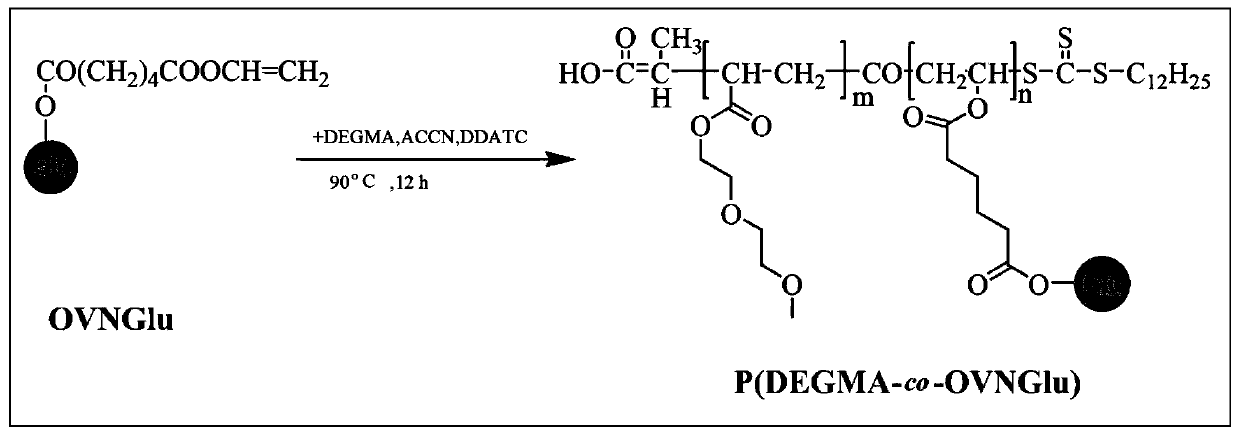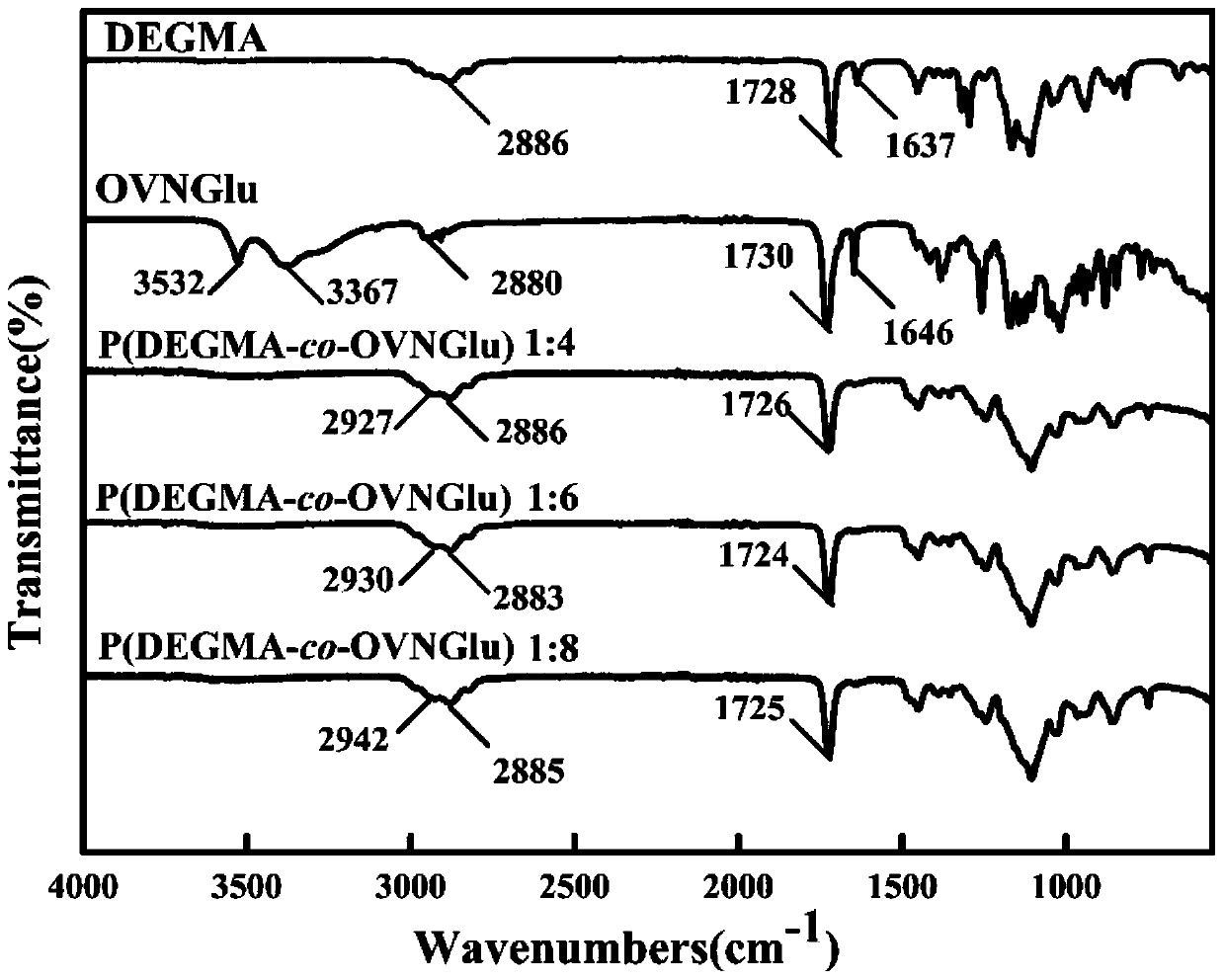Method for testing interaction of temperature-sensitive random polymer with agglutinin
A determination method and polymer technology, which can be used in the preparation of test samples, measurement of scattering properties, measurement of color/spectral properties, etc., can solve the problems of unclear identification process between sugar-based polymers and lectins, and achieve fast test analysis. , Simple operation, low cost effect
- Summary
- Abstract
- Description
- Claims
- Application Information
AI Technical Summary
Problems solved by technology
Method used
Image
Examples
Embodiment 1
[0044] Preparation of P(DEGMA-co-OVNGlu): DDATC was used as chain transfer agent and ACCN was used as initiator. Take 0.3313g DEGMA, 0.1470g OVNGlu, 8.08mg DDATC, 0.305mg ACCN dissolved in 1.5mL DMF solution, after 3 times of vacuum-filling nitrogen cycle, react in 90℃ oil bath for 10h, then place in liquid nitrogen to cool for 30s . The reaction product was precipitated with n-hexane, dialyzed for 3 days, and freeze-dried to obtain a yellow oil, which was a temperature-sensitive random polymer P(DEGMA-co-OVNGlu) with a molar ratio of OVNGlu and DEGMA of 1:4. The synthesis method of temperature-sensitive random polymers with OVNGlu and DEGMA molar ratios of 1:6 and 1:8 is the same as above, DEGMA is 0.3561g and 0.3685g, OVNGlu is 0.1029g and 0.0808g, respectively, figure 2 It is the synthetic route of P(DEGMA-co-OVNGlu).
[0045] The above-mentioned three kinds of random polymers with different ratios, thermosensitive monomer DEGMA and sugar ester monomer OVNGlu were tested...
Embodiment 2
[0049] Dissolve the 1:4 random polymer in Example 1 in the HEPES buffer to make polymers with concentrations of 0.005mg / mL, 0.05mg / mL, 0.1mg / mL, 0.3mg / mL, and 0.5mg / mL solution with a volume of 10 mL. The obtained series of solutions are filtered with a 0.45 μm aqueous phase filter membrane, and then added to a clean sample test bottle. First, test (the test angle is 90°, and the test time for each pair of interactions is 3min) of different concentrations of no The particle size of the regular polymer in HEPES buffer (D h ) and polydispersity (PDI), such as Image 6 shown. The results show that: for 37℃ nonlinear (T>LCST) random polymer, with the increase of polymer concentration, D h Gradually increases, PDI gradually decreases. When the polymer concentration is 0.005 mg / mL, the particle size of the polymer is 4.7nm, because the dust removal of the high polymer solution and its solvent is very important when testing light scattering, so the dust particles have a large eff...
Embodiment 3
[0051] (1) Prepare 0.4mg / mL P(DEGMA-co-OVNGlu): pipette 12mL of prepared 1mg / mL (20mL) P(DEGMA-co-OVNGlu) into a 50mL centrifuge tube, and then add 18 mL of the prepared HEPES buffer solution (pH=7.4), the obtained solution is 0.4 mg / mL P(DEGMA-co-OVNGlu) solution (30 mL).
[0052] (2) Prepare 0.4mg / mL Con A: Pipette 12mL of the prepared 1mg / mL (20mL) Con A into a 50mL centrifuge tube, and then add 18mL of the prepared HEPES buffer solution (pH = 7.4), the obtained solution is 0.4mg / mL Con A solution (30mL).
[0053] (3) Prepare 0.4mg / mL BSA: pipette 12mL of the prepared 1mg / mL (20mL) BSA into a 50mL centrifuge tube, and then add 18mL of the prepared HEPES buffer solution (pH=7.4) , the resulting solution was 0.4 mg / mL BSA solution (30 mL).
[0054] (4) Configure 0.4mg / mL RCA 120 : The prepared 1mg / mL (20mL) RCA 120 Pipette 12 mL into a 50 mL centrifuge tube, and then add 18 mL of the prepared HEPES buffer solution (pH=7.4), the resulting solution is 0.4 mg / mL RCA 120 sol...
PUM
| Property | Measurement | Unit |
|---|---|---|
| concentration | aaaaa | aaaaa |
| concentration | aaaaa | aaaaa |
| concentration | aaaaa | aaaaa |
Abstract
Description
Claims
Application Information
 Login to View More
Login to View More - R&D
- Intellectual Property
- Life Sciences
- Materials
- Tech Scout
- Unparalleled Data Quality
- Higher Quality Content
- 60% Fewer Hallucinations
Browse by: Latest US Patents, China's latest patents, Technical Efficacy Thesaurus, Application Domain, Technology Topic, Popular Technical Reports.
© 2025 PatSnap. All rights reserved.Legal|Privacy policy|Modern Slavery Act Transparency Statement|Sitemap|About US| Contact US: help@patsnap.com



